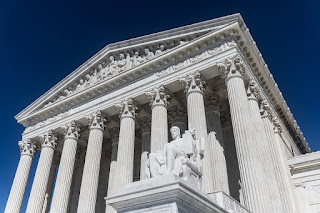Oyez! Oyez! Oyez! Resources to Understand the U.S. Supreme Court
by Mary Ellen Daneels, Instructional Specialist
Monday marks the start of a new term for the Supreme Court of the United States (SCOTUS). The 2019-20 term is sure to provide many teachable moments as SCOTUS takes up issues related to immigration, abortion, gun rights, and LGBTQ workplace discrimination. For #CivicsInTheMiddle classrooms, there are plenty of opportunities to use the courts to engage in the proven practices of civic education embedded in both the middle and high school civics mandates. Here are some resources to start with.
Direct Instruction on the Supreme Court
- The official website for the United States Supreme Court allows access to a variety of information on the Court, including a calendar and schedule for the current term, and the audio from oral arguments, posted each Friday after arguments take place. There is also an overview of the Supreme Court where you can research the Court’s procedures and biographies of justices.
- iCivics has a curriculum packet on the judicial branch that explores the courts’ role in settling disputes and administering justice, and the unique role of the U.S. Supreme Court in interpreting the U.S. Constitution.
- The National Constitution Center has a Judge Chats lesson plan in which students explore the requisite skills necessary to become a judge that can lead to an informed conversation with a visiting judge.
- Annenberg Foundation has a lesson plan on judicial independence in which students consider the importance of an independent judiciary to the preservation of constitutional democracy and the quality of life for all Americans.
- The American Bar Association Division for Public Education has differentiated lessons for both middle and high school students on justice and the rule of law.
- PBS Learning Media Illinois has lesson plans related to the importance of precedents, civil rights & civil liberties, federalism, and landmark cases.
- For more resources around landmark SCOTUS cases in history, peruse the offerings from the Annenberg Foundation, the Bill of Rights Institute, and Street Law with the Supreme Court Historical Society.
- Street Law has ready to go resources to support students engaging in moot courts, mini-moot courts, the issuance of the writ of certiorari, and other judicial processes.
- The Constitutional Rights Foundation has several powerpoint presentations on free expression cases to prepare students to participate in a moot court.
- iCivics has online games to simulate the workings of the court including Supreme Decision, Argument Wars, and Court Quest.
- ABA Division for Public Education publishes a Supreme Court Preview plain-language analysis of all cases given a plenary review by the Supreme Court in advance of oral argument using a combination of charts, statistics, case summaries, and essays.
- The New York Times Supreme Court site contains news articles about recent SCOTUS decisions. The site also contains links to articles relating to each of the Justices, interactive multimedia features, and a summary of the notable cases from the present term.
- More Perfect Podcast, from WNYC and Radiolab, tells the stories underlying important Supreme Court decisions, how those decisions affect the lives of the American people.
- Street Law has resources for students to explore two pending cases before the court, Bostock v. Clayton County, GA & Altitude Express, Inc. v. Zarda and R.G. & G.R. Harris Funeral Homes, Inc. v. Equal Employment Opportunity Commission and Aimee Stephens.
- The Oyez website has a succinct summary of all cases to be argued this term.
- Dan Fouts in his Socrates Questions blog has created some sample prompts for the Supreme Court comparison FRQ that leads to a larger discussion around the question, “How does the Supreme Court make sure that the law stays stable but doesn’t stand still?”





Comments
Post a Comment